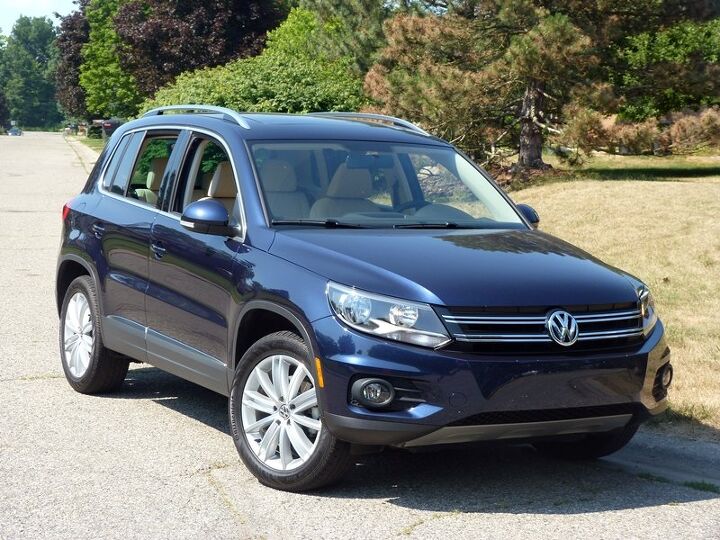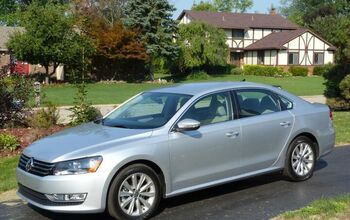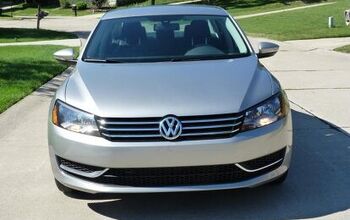Review: 2012 Volkswagen Tiguan SE AWD
Some driving enthusiasts (for reasons that escape me) take their significant other’s tastes into account when buying a car for themselves. Invariably, the s.o. won’t abide a hatchback, but finds crossovers the epitome of automotive style and utility. So our whipped enthusiast wonders which compact crossover they will least regret. Oh, and it can’t cost BMW money. Volksagen, Mazda, and Ford offer the most entertaining hot hatches. What do they offer in something a little taller? Today we examine Europe’s (relatively) affordable offering, the Volkswagen Tiguan.
Interior updates lend the interior a slightly less downscale ambiance, but the cabin’s basic character remains functional rather than stylish. The controls are simple by current standards, and easy to reach and operate. The driving position is more upright, and so less car-like, than more recently designed compact crossovers. Depending on personal tastes, this isn’t necessarily a bad thing. The instrument panel seems a little too tall, perhaps to provide some real truck flavor, but it’s not deep. Raise the seat an inch and forward visibility is good. Rearward visibility not so much, but it’s better than in swoopier competitors. A good thing, as neither a rearview camera nor a blind spot warning system is offered.
With no substantial changes to its body, the Tiguan remains among the more compact of compact crossovers. Its wheelbase and length are three to four inches briefer than those of the entirely new Mazda CX-5 and Ford Escape. Passenger space isn’t much affected, though. According to the official specs, the VW has 4.4 inches less total legroom than the CX-5, a big difference. In person, I had an equally generous amount of rear legroom in both of them. (We’ll discuss the Ford’s rear seat later in this series.) Unlike that in the Mazda, the VW’s comfortably high rear seat slides and reclines.
No such magic was worked with the Tiguan’s cargo area. The VW’s deficit might not be as large as the official specs suggest (56.1 cubic feet vs. 64.8 in the Mazda and 67.8 in the Ford), but there is a deficit. The only folding front passenger seat in the threesome (which goes away with the SEL) compensates.
Ironically, the German-engineered and manufactured Tiguan has the least “European” dynamics of the three. Its steering feels relatively loose on center and considerably lighter in all situations. Its seats and suspension tuning are similarly the softest in this bunch, if still firmer than you’ll find in a Honda or Toyota. The Tiguan’s handling is composed and even confidence-inspiring, but not especially sporty. A GTI with a suspension lift it isn’t; a Rabbit with a suspension lift, perhaps.
The Tiguan has one clear advantage over the CX-5. Both have a single engine option (and thus no options at all), a 2.0-liter four-cylinder. But the VW’s has a turbo, and 200 horsepower compared to the Mazda’s 155. The difference in straight line performance is readily evident even in casual driving. The Mazda engine often sounds and feels like it’s straining, the VW engine rarely if ever does.
According to the EPA ratings, the Tiguan isn’t nearly as fuel-efficient as the Mazda, 21 city / 27 highway vs. 25/31. In all but the most casual driving the real-world difference seemed about half as large (26 vs. 28 in the suburbs, if the trip computers are to be believed). For a crossover with a powerful engine and all-wheel-drive, the VW’s real-world numbers might actually be the more impressive.
Not that all is top notch with the Tiguan’s powertrain. You’ll find no quick-shifting, quick-witted DSG transmission in this VW, at least not on this side of the Atlantic. Instead, a conventional six-speed automatic supplied by Aisin (a Toyota affiliate) too often lurches, lugs the engine, or swaps cogs when no swap seems necessary.
The Tiguan’s handling might not be terribly Teutonic, but its price is. The tested 2012 “SE AWD with Sunroof and Navigation” listed for $33,300. For the 2013, add another $430. Similarly equip a Mazda CX-5 with sunroof and nav, and it lists for $3,315 less. Did we mention that, so configured, the Tiguan has vinyl upholstery, while the CX-5 has red-stitched black leather and a considerably more upscale ambiance? The Mazda’s lower price also includes larger wheels, a premium Bose audio system, power driver seat, proximity key, blind spot warning system, rearview camera, an auto-dimming rearview mirror with Homelink, dual zone automatic climate control, and steering-linked HID headlights. Adjust for this extra stuff (save the wheels and audio) using TrueDelta’s car price comparison tool, and the Mazda emerges with a nearly $6,000 price advantage. You can equip the Tiguan past the CX-5’s level by opting for the SEL, but then the sticker tops $38,000.
Despite (or in cases because of) the noted shortcomings, my wife strongly preferred the Tiguan over the other two, with their more steeply raked windshields, heavier steering, and less compliant suspensions. My wife is not a driving enthusiast. Neither are most buyers in this segment. But even those who prefer how the Tiguan drives won’t prefer how much it costs.
Volkswagen provided an insured vehicle with a tank of gas.
Michael Karesh operates TrueDelta.com, an online source of car reliability and pricing information.
Michael Karesh lives in West Bloomfield, Michigan, with his wife and three children. In 2003 he received a Ph.D. from the University of Chicago. While in Chicago he worked at the National Opinion Research Center, a leader in the field of survey research. For his doctoral thesis, he spent a year-and-a-half inside an automaker studying how and how well it understood consumers when developing new products. While pursuing the degree he taught consumer behavior and product development at Oakland University. Since 1999, he has contributed auto reviews to Epinions, where he is currently one of two people in charge of the autos section. Since earning the degree he has continued to care for his children (school, gymnastics, tae-kwan-do...) and write reviews for Epinions and, more recently, The Truth About Cars while developing TrueDelta, a vehicle reliability and price comparison site.
More by Michael Karesh
Latest Car Reviews
Read moreLatest Product Reviews
Read moreRecent Comments
- Lorenzo The unspoken killer is that batteries can't be repaired after a fender-bender and the cars are totaled by insurance companies. Very quickly, insurance premiums will be bigger than the the monthly payment, killing all sales. People will be snapping up all the clunkers Tim Healey can find.
- Lorenzo Massachusetts - with the start/finish line at the tip of Cape Cod.
- RHD Welcome to TTAH/K, also known as TTAUC (The truth about used cars). There is a hell of a lot of interesting auto news that does not make it to this website.
- Jkross22 EV makers are hosed. How much bigger is the EV market right now than it already is? Tesla is holding all the cards... existing customer base, no dealers to contend with, largest EV fleet and the only one with a reliable (although more crowded) charging network when you're on the road. They're also the most agile with pricing. I have no idea what BMW, Audi, H/K and Merc are thinking and their sales reflect that. Tesla isn't for me, but I see the appeal. They are the EV for people who really just want a Tesla, which is most EV customers. Rivian and Polestar and Lucid are all in trouble. They'll likely have to be acquired to survive. They probably know it too.
- Lorenzo The Renaissance Center was spearheaded by Henry Ford II to revitalize the Detroit waterfront. The round towers were a huge mistake, with inefficient floorplans. The space is largely unusable, and rental agents were having trouble renting it out.GM didn't know that, or do research, when they bought it. They just wanted to steal thunder from Ford by making it their new headquarters. Since they now own it, GM will need to tear down the "silver silos" as un-rentable, and take a financial bath.Somewhere, the ghost of Alfred P. Sloan is weeping.











































Comments
Join the conversation
"I’d be glad to give an update, if we have it in five years. It’s on a three-year lease now,– which matches the warranty, so I consider it a risk-free deal." -----Wheatridge Gee Wheatridge, if the reliability and durability is all irrelevant, why did you say that in your impromptu review? (which was excellent, by the way).
Michael - I think by 'no rearview camera', you meant in this particular SE. The SEL has the rearview cam and the 2011 and prior also had a manual passenger seat in the SEL (that kept the fold flat front seat - a potential reason to look for a used Tiguan if you want SEL trim). Owning a 2011 SEL (Premium with the RN510 nav and Dynaudio), I can say I enjoy the 'full Monte' VW experience. We have 24,000 miles on ours in 15 months. Only one return to the dealer for an initial throttle position issue (out of the factory prob at 3k). This, not surprisingly, is the wife's vehicle. She picked it after driving EVERY OTHER small CUV at the time (hence no current gen Escape or CR-V). I've driven them all as well and agree with your assessment. The Tiguan is definitely softer riding than most would expect but also significantly quieter than all but the CX-5. The CX-5 was just coming out when we bought the Tiguan (July 2011) but SkyActiv is still NoTorqueActiv and would be hard to live with day-to-day. Personally, I think out of all the CUVs currently out - I'd go with a new Escape with the 1.6T. It is far more refined than the competition (other than the Tiguan). Also, I'm a Hyundai/Kia fan but the Tucson and Sportage are just not in the same league as the Escape (or Tiguan) when it comes to chassis tuning. They are literally the worst ride/handling combo you can buy in this size CUV. The real trump card to me is who gets to North America first with a diesel in this group...Appears it will be Mazda with the 2.2 oil burner in the CX-5 but Mazda still has limited resources vs VW and others. The Tiguan - as it was meant to be - with the 2.0TDI like in Europe, would be the perfect vehicle for our needs.